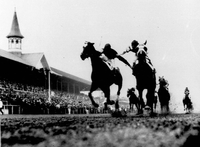Evaluate and place these aged Arabian mares in your order of preference. Then see how your choices compare to our expert judge's.
 |
As someone who rides performance horses, I'll always prefer a horse I think is usable, versus one that's "just a pretty horse." And I feel compelled to stick to the class specifications and criteria set forth by Arabian judging standards.
We have to consider a horse in this order: Arabian type, conformation, suitability as a breeding animal, quality, movement, substance, manners and presence.
So, as an Arabian judge, the first thing I evaluate is type, which is basically made up of the characteristics that distinguish an Arabian horse from other breeds. There are five main points of type: head, neck, back, croup and tail. Because the horses in these photos are standing still, it's difficult to judge criteria like movement, presence and tail carriage. But I'll evaluate suitability as a breeding animal because this is a class of mares. "Like breeds like," so to me, good conformation and type contribute to a horse's suitability for breeding.
Click "Next" to find out how I placed these three aged Arabian mares.
First: Mare C I would, however, like her to have a little more angle to her pasterns for better shock absorption and soundness. While I can't judge movement from a photo, I can make some assumptions by studying her body angles and leg structure. Based on those, I'd expect this mare to be the best mover of the class. She has good hip angulation and overall balance, which suggest it'll be easiest for her to hold up to the rigors of performance.
Second: Mare B This mare has the best angle to her hip, but it appears (at least in this picture) that she camps out behind--if you dropped a plumbline from the point of her buttocks, the mare's hocks and fetlocks would stand behind that line. Because she's camped out behind (which will make it more difficult for her to engage her hindquarters) and she has a steep shoulder, she probably won't be the athlete that the first-place horse may be.
Third: Mare A She has a short and borderline "rafter-type" hip (a flat hip, shaped like a "T" from behind), both of which can make it more difficult for her to collect and work from behind. Her long cannon bones could make her more susceptible to injury. She doesn't have good muscling, her joints are small, and her body conformation is not well-balanced, all of which tell me she'll have to work a lot harder than a well-conformed horse, and may have difficulty holding up to the demands of performance work. Michael Damianos operates Michael Damianos Performance Horses at Starbuck's Ojai Valley Ranch in Ojai, Calif., where he lives with his wife, Dawn, and daughters. A trainer for 25 years, he trains and shows Arabian performance horses at the regional and national level in Western pleasure, reining, trail, driving, and English classes, and coaches youth and amateur riders. He's a carded judge for the Arabian Horse Association, AQHA, ApHC, APHA, NRHA, NRCHA and NSBA. This article originally appeared in the September 2007 issue of Horse & Rider magazine. Enter Your Horse in Conformation Clinic! To submit a photo of your horse to be evaluated in Horse & Rider's Conformation Clinic, send us a left-side view photo of your horse (for digital phots: high-resolution, 300 dpi, in at least 3" x 5"). Make sure he's well-groomed, looking straight ahead and standing on level ground--and try to avoid distracting backgrounds. Email amanda.peterson@equinetwork.com and include your contact info and your horse's breed, age, gender and height. |
| Find this article at: http://www.equisearch.com/horses_care/health/anatomy/agedarabians_082207/index1.aspx |
Trackback URL : 이 글에는 트랙백을 보낼 수 없습니다
Trackback RSS : http://www.fallight.com/rss/trackback/1339
Trackback ATOM : http://www.fallight.com/atom/trackback/1339










